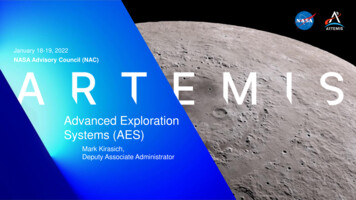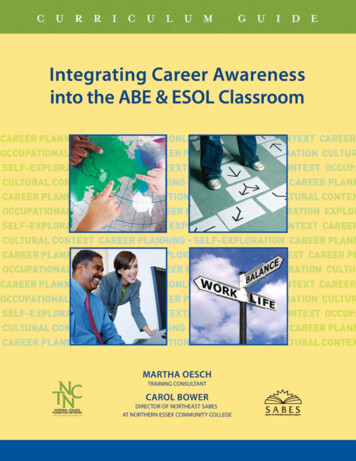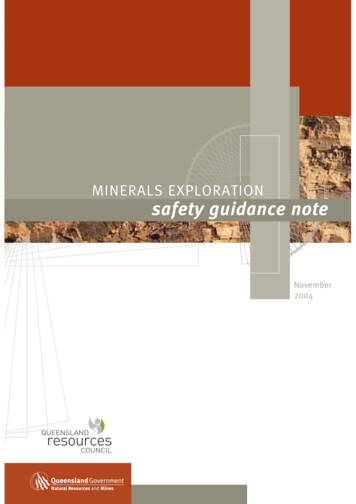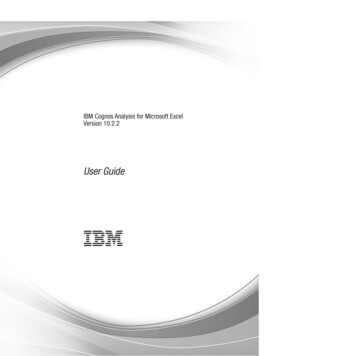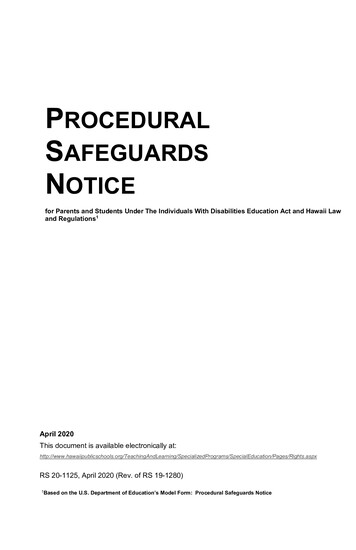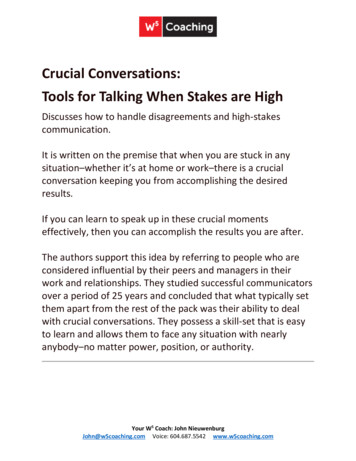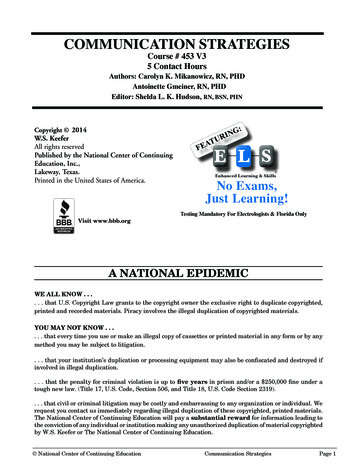
Transcription
Communication Exploration: DeafnessTalking and Learning withSight and SigningWhat Is Deafness? Lead a class discussion, encouraging students toI Am DeafDon’t talk loud or yell at me.It won’t help.Please tap me lightly or turn thelights on and off to get my attention.Always face me when you aretalking to me.If you don’t know how to sign,please write notes or gesture to me.Please understand that Englishmay not be my first language anddon’t make fun of me if my writtenEnglish is not correct or my speechsounds different.Tell me what is happening whenfriends are talking together ina group.g—Anne Marie Smith, The LearninCenter for Deaf Childrenshare background knowledge and personal experiences. Introduce theinformation below into the conversation.There are different degrees of hearing loss. Some people are hard-ofhearing. This means they cannot hear everything. People who arehard-of-hearing often use hearing aids to help make sounds louder.People who are deaf cannot hear at all. They often use sign languageto converse. Most children who are deaf have families who can hear.Encourage children to pose questions, such as: How do you becomedeaf? Can someone who is deaf speak? Write the questions on a chart.Search out answers together as you share the “I Am Deaf” sidebar text,read Kid Talk (page 11), and some of the Books for Kids (page 10). Formore information, see the books and Web sites referenced in Resources(page 16).Kid Talk: Activity Sheet (page 11) . Read and discuss the interviewwith the class. Ask: What other questions would you ask KP and Derek?Add these questions to your chart. Practice the American Sign Language(ASL) sign for “friends” taught in the photograph. Students also may wantto try the signs for “hello” and “join in,” which D.W. and Buster are signingbelow. Encourage students to take this worksheet home and teach the ASLsigns to family members.Explore Closed Captions. Watch a few minutes of an ARTHURepisode with the sound turned off. Ask: Did you understand the show?Then turn on the closed captions. (See directions below.) The editedcaptions are ideal for second grade students. Ask: What did the captionsinclude besides the characters’ words? How can captions help people whocan’t hear? How can they help people who can hear?To view closed captions on yourTV, use the remote control oron-screen menu. For A RTHURprograms, select “CC1” fororiginal captions or “CC2” foredited, easy-to-read captions.When you record a show onyour VCR, the closed captionsare also recorded. To viewthe captions when you watchthe tape, use the remotecontrolor on-screenmenu.Using American Sign Language (ASL),D.W. signs, “Hello!” and Buster signs, “Join in!”9Visit ARTHUR online at pbskids.org/arthur
Create Your Own Captions: Activity Sheet (page 12).Distribute the activity sheet and read the directions together. Share anddiscuss the completed worksheet.Fingerspelling Word Puzzle: Activity Sheet (page 13).In American Sign Language (ASL), most words or phrases are representedby one motion. Fingerspelling is used for certain words, such as names.Distribute the activity sheet and encourage students to practice thefingerspelling alphabet. As students fingerspell, they should try to keeptheir arms motionless and use only their wrists and fingers to make theletters. Next, have children work in pairs or small groups to solve theword puzzle. Words hidden in the puzzle include: stop, car, pond, tag, red,and sand.ASL Animal Go Fish. Interested children can learn the ASL signsfor several animals and teach the signs to friends. Some good resources areHandtalk Zoo by Mary Beth Miller and the Web sites:www.lessontutor.com/eesASLFarm.html andBooks for K idsA Button in Her Ear by AdaBassett LitchfieldDad and Me in the Morning byPat LakinElana’s Ears, or How I Becamethe Best Big Sister in the Worldby Gloria Roth LowellHandtalk Zoo by Mary BethMiller and George Ancona(photographer)Moses Goes to a Concert by IsaacMillmanA Place for Grace by Jean DaviesOkimotoEyewitness Explorers: HumanBody by Steve Parker, Deni Bownwww.lessontutor.com/eesASLgrassland.html.Let children choose eight animals whose names they can sign. Help themmake a card deck of 32 cards with 4 cards for each animal. Have them drawor cut out pictures of the animals andwrite the name below. Use the card deckto play an ASL version of Go Fish.Partner A will ask for a card by makingcatthe sign of the animal. Partner B will signdograbbitback either yes or no.To sign no in ASL,bring your rightindex, middle finger,and thumb together.American Sign Language(ASL) is a language. Just likeEnglish or Spanish, it has agrammar system, but in ASLgrammar, the rules involvethe way you use space (theair in front of you), how youmove your hands, and howyou use facial expressionsto convey meaning.This child and womanare signing, “I love you.”10A RT H U R ’ S CO M M U N I C AT I O N A DV E N T U R EPhoto by Lisa TannerTo sign yes in ASL,nod your fist upand down in frontof you.
Derek and Kirsten-Paige (whose nickname is KP) are nine years old. They attenda school for children who are deaf. Here’s what they said in an interview.Q: Tell me about your brothers or sisters.Derek: I have a big sister who is twelve and a little sister who is two. My older sisteris deaf. My baby sister is hearing but I’m teaching her how to sign a little.Q: Do you play sports? Who do you play with?KP: I used to play basketball here at school. Now I play soccer and basketball withhearing kids in my town.Q: What’s your favorite part of school?Derek: I like science because I like to try different things and see what happens.Q: How do you communicate with hearing kids?KP: Sometimes we write on paper what we want to say, and sometimes we gesture.Also, I read lips a little bit. On my basketball team, a couple kids wanted to knowhow to sign, so I taught them some signs.Q: What do you like hearing kids to do when they first meet you?Derek: I like them to gesture, so we can talk and be friends. I have a neighborwho’s a friend. My dad said, “Come and play basketball with us.” So he cameover, and now we play together. We have our own way of talking to each other.2Photos by Lisa Tanner1At the top of the page, Derek and KP are usingAmerican Sign Language (ASL) to say friends.To sign friends, hook your right index fingerover the left, then switch and hook your leftindex finger over the right.right over leftleft over right11AC T I V I T Y S H E E T 2002 WGBH Educational Foundation. All rights reserved. Underlying TM/ Marc Brown. Permission is granted for reproduction of this printed material for educational use only.lkiTdaK
Date:Name:C rea te Your Own CaptionsCaptions are words that appear on the television screen. Sometimes the words arewhat the characters are saying. Sometimes they are sound effects like “phone ringing!”Draw your own scenes. Write a caption below each one.Cut out these caption strips.(ball hitting bat loudly)12AC T I V I T Y S H E E TYou can do it, Arthur!Yay, we won!Hip, hip, hooray! 2002 WGBH Educational Foundation. All rights reserved. Underlying TM/ Marc Brown. Permission is granted for reproduction of this printed material for educational use only.Cut out the three caption strips at the bottom of the page.Match each caption with the correct picture.
13AC T I V I T Y S H E E TDate:onpcqeLook at each fingerspelling picture.Write the matching letter in thebox on the right.Find and circle the hiddenwords in the box on the right. Find at least five hidden words inthis puzzle.bafghijklmstuvwxyz 2002 WGBH Educational Foundation. All rights reserved. Underlying TM/ Marc Brown. Permission is granted for reproduction of this printed material for educational use only.ra b c d e fgh i j k l mn o p q r s t u v w x yzs t op Sca r oign nl r e ddzuzl esegpnPrrnWgldlioiF eTry signing the alphabet.Name:
Communication Exploration: Wrap-UpReflections and Projects“ Inour culture it is notunusual for people to beuncomfortable aboutdisabilities. In most cases,the discomfort is the resultof a lack of information.Provide information andpersonal contact anddiscomfort is eased. ”—Beth Mendel, UnderstandingOur Differences, Inc.Make Classroom Communication Inclusive. List some commonclassroom events: a knock at the door, assignments written on the board,a P.A. announcement, raised fingers to signal “quiet down.” For each, ask:Would someone who is blind or has limited vision get the message?Would someone who is deaf or hard-of-hearing? How could we make this message accessible to all? How would it help everyone to have the message conveyed in more thanone way? Cool Tools! Activity Sheet (page 15). Reproduce and distributeCool Tools. Have children complete Part 1 with a partner, or in smallgroups. Then discuss: How do you think each cool tool might be useful foryou? Next, have children work with a partner, or in small groups tocomplete Part 2. Encourage students to use pictures as well as words toexplain their cool tools invention ideas. Provide time for class sharing.Tactile Picture Books: Class Project. Make a picture book withtactile art that children who are blind (as well as those who are sighted)can enjoy by touching. Help students retell a familiar story or create anoriginal one. Let them use different fabrics and textured materials toillustrate each page. You may want to present the book as a gift to ahospital, daycare, or other organization that works with children who areblind or visually impaired.Community Fieldtrips.You may be able to plan a visit to a localmovie theater equipped with Motion Picture Access (MoPix ), technologythat makes movies accessible to people who are deaf, hard-of-hearing,blind, or visually impaired. To find a location near you, go towww.mopix.org. Also, check local offerings to see if you can attend a playor concert for children that is ASL interpreted.Pen Pals. Contact a local school for children who are deaf or blind to seeif your class can establish a pen pal relationship with a classroom there.Eventually, you may want to extend this experience and plan a shared event.Classroom Speaker. If possible, invite a member of your communitywho is blind or deaf to visit your class. Contact a local school or organization.The Resources section (page 16) provides information about arranginga visit from a speaker who is blind. You may want to invite your visitorto read a book to the class using a picture book with braille overlay, orpresent a book together, asking your visitor to translate into ASL(American Sign Language) as you read aloud. Prepare students for thevisit by reading some of the informational Books for Kids (pages 5 and 10)and brainstorming questions to ask your visitor.Reflections. Have children write about what they have learned throughthis “Communication Adventure.” What activities did they most enjoy?What questions do they still have?14A RT H U R ’ S CO M M U N I C AT I O N A DV E N T U R E
Date:Name:Cool Tool s!Part 1Look at each item from the Cool Tools Catalog. Was it designed for people whocan’t see or for people who can’t hear? Mark your answer.COOL TOOLSOGL S C ATA LCOOL TOOakeShake-Me-AwAlarm Clockoccer ball beepsyou cansotell where it is. Someonewho Someone w can’t seeho can’thearcan’t see Someone whoho can’t hear Someone wTeletypewriterdgetFill-It-Up-GaNeed tocall a friend?Type messages toeachother ona TTY telephone. Someonewho Someone w can’t seeho can’theare rim ofPut this on theps whenyour cup. It beost full.the cup is alm LSCOOL TOOILLUSOGBeeping Soccer BallThis srm clock undePlace this alarwill vibrateyour pillow. Itto wake you.Someone whocan’t seeho Someonearwcan’t heC ATA LILLUSTRATIONS:BonnieMatthewsCOOL1TOOLS2ews: Bonnie MatthTRATIONSPart 2Invent your own cool tools! How would you make. a doorbell that will alert someone who can’t hear?HINT:Think of all thesenses peoplecan use. picture book for a child who can’t see? board game that everyone can play?Draw and write your answers on a separate piece of paper. 2002 WGBH Educational Foundation. All rights reserved. Underlying TM/ Marc Brown. Permission is granted for reproduction of this printedmaterial for educational use only.15AC T I V I T Y S H E E T
ResourcesACCESSIBLE VIDEOSAND MOVIESDescribed videos and videos withclosed captions are available atmost public libraries. You can alsorecord TV programs with thesefeatures intact (see pages 5 and 9).To purchase described videos ofARTHUR episodes, visit the DVSHome Video online catalog For information on movies withdescriptive narrations and closedcaptions and a listing of wherethey are playing locally, visit theCPB/WGBH National Center forAccessible Media site at:ncam.wgbh.org/mopixCLASSROOM SPEAKERSWould you like to invite an adultwho is blind to speak to your class?A local chapter of the NationalFederation of the Blind canhelp you make arrangements.National Federation of the Blind:BRAILLE ALPHABET CARDS;BRAILLE SLATE AND STYLUSAMERICAN SIGN LANGUAGE ANDFINGERSPELLING ON THE WEBPackets of braille alphabet cardsare available through the HowePress at Perkins School for theBlind at: perkins.pvt.k12.ma.usFor an animated American SignLanguage dictionary, visit theAmerican Sign Language Browsersite at: e: (410) 659-9314e-mail: nfb@nfb.orgaslweb/browser.htmMORE INFORMATIONWith a slate and stylus, yourstudents can write in braille.Order from American PrintingHouse for the Blind at: aph.org(cost approximately 6).Type in a word and see itfingerspelled at the ASLFingerspelling site:BRAILLE BOOKSBRAILLE ON THE WEBBraille children’s books are availableat most public libraries. To orderbooks in braille, visit the followingWeb sites: Seedlings Braille Booksfor Children at: seedlings.org andNational Braille Press at: nbp.orgBraille Bug is a great Web site forkids: tmlFINGERSPELLING ANDBRAILLE FONTSMake your own worksheets andsigns using fonts from the TexasSchool for the Blind and VisuallyImpaired. Find the fonts at:tsbvi.edu/Education/fonts.htmlGood sources of information aboutblindness and visual impairmentinclude: Children with VisualImpairments: A Parent’s Guideby M. Kay Holbrook American Foundation for theBlind Web site: afb.orgGood sources of information aboutdeafness and hearing impairmentinclude: Web site for Beginnings, anorganization for parents ofchildren who are deaf or hard-ofhearing: beginningssvcs.com Web site for American SpeechLanguage-Hearing Association at:asha.orgThe contents of ARTHUR’s Communication Adventure activity guide were supported under the Ready-To-Learn Television Program, P/R Award Number R295A00002, as administered by the Office of Educational Research and Improvement, U.S. Department of Education.However, the contents do not necessarily represent the policy of the Department of Education, and you should not assume endorsement by the Federal Government. 2002 WGBH Educational Foundation. All rights reserved. All characters and underlying materials(including artwork) copyright by Marc Brown. Arthur, D.W., and the other Marc Brown characters are trademarks of Marc Brown. “PBS KIDS” is a trademark of PBS. All third party trademarks are the property of their respective owners. Used with permission.16A RT H U R ’ S CO M M U N I C AT I O N A DV E N T U R E
D e a r Ed u c a to r,r the PBSroud to sponsop isalrecesit RTHURPost Alpha-Bmming like AragroP.esriich vision sen, both of whfudanARTHUR teleonticauiscoverfect mix of edexplore and dtoprovides a pereiresd’sdfueling a chilare critical tofer.orld has to ofnceall that the wto the importadteitmmcoyes kidsits is especiallcereal providPost Alpha-Bedaph-serttur unique lespell wordsof reading. Othey need toetabhpaleers of the excited towith all 26 lettd minds. We aransnioatinr imagre because itand feed theition AdventuaicnumomCeople whour’sbetter with pesponsor Arthaticnummn how to coany childhelps kids learuable skill foralvinan—from themare differenterse world.in today’s divts find thesed your studenanouyatthits hopesPost Alpha-Benjoyable.e helpful andbtolsiaeratmSincerely,Po st A lp h a -B it sD e a r Ed u c a to r,Chuck E. Cheese’s is proudto sponsor ARwinning PBSTHUR, thetelevision seriawardes. Like the crwe at Chuckeators of ARTHUE. Cheese’s reR,cognize that hintegral partaving fun is anof a child’s development.Chuck E. Cheese’s is especially proud to suCommunicatipport Arthur’on Adventuresbecause of ourto foster wholcommitmentesome, empowering, inclusivthat encourage environmene all childrentsto communicatin enjoyable weand interactays, regardless of their agbackground,e, sex, ethnicor their physical or emotional challenges.Chuck E. Cheese’s hopes thisguide will heldiscover howp studentsto communicatebetter in theiwork, and inr play, in theiall their socialrinteractions.Here’s to ARTHUR and the joy of learning.Chu c k E . C h e e se’s
D.W.ng,is signi”“Hello!Busteis sig rn“Join ing,in!”Buster andD.W. are usingAmerican SignLanguage.WGBHEducational Programming and Outreach125 Western AvenueBoston, MA 02134pbskids.org/arthurARTHUR is produced by WGBH Boston and CINAR. Funding for ARTHURis provided by a Ready-To-Learn Television Cooperative Agreementfrom the U.S. Department of Education, through the Public BroadcastingService, and public television viewers. Corporate funding is provided byLibby’s Juicy Juice , Post Alpha-Bits Cereal, and Chuck E. Cheese’s .Nonprofit OrganizationU.S. PostagePAIDBoston, MAPermit No. 51738
American Sign Language (ASL) is a language. Just like English or Spanish, it has a grammar system, but in ASL grammar, the rules involve the way you use space (the air in front of you), how you move your hands, and how you use facial expressions to convey meaning. B o o k s f r K i d s To sign no in

